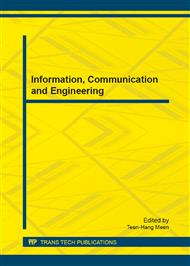[1]
A Weiss, Computing in the Clouds, NetWorker, 11(4) (2007) 16-25.
Google Scholar
[2]
R Buyya, CS Yeo, S Venugopal, Market-Oriented Cloud Computing,Vision, Hype, and Reality for Delivering IT Services as Computing Utilities, Proceedings of the 2008 l0th IEEE International Conference on High Performance Computing and Communications, 2008, pp.5-13.
DOI: 10.1109/hpcc.2008.172
Google Scholar
[3]
Dean J, Ghemmawat S. MapReduce, Simplied data processing on large clusters, Proceedings of the 6th Sympesium on Operating System Design and Implementation, New York, ACM Press, 2004, p.137 – 150.
Google Scholar
[4]
Chu C T, Kim S K, Lin Y A, Yu Y, Bradski G R, Ng A Y, Olukotun K, Map-Reduce for Machine Learning on Multicore, 2006, pp.281-288.
Google Scholar
[5]
Ghemawat S, Gobioff H, Leung S T, The Google file systern, Proceedings of the 19th ACM Symposium on Operating Systems Principles, New York, ACM Press, 2003, pp.29-43.
DOI: 10.1145/945445.945450
Google Scholar
[6]
Chang F, Dean J, Ghemawat S, et al. BigTable, A distributed storage system for structured data, ACM Transactions on Computer Systems, 26(2)(2008)1-26.
DOI: 10.1145/1365815.1365816
Google Scholar
[7]
Xiang Xiaojun, Gao Yang, Shang Lin, Yang Yubin, Parallel Text Categorization of Massive Text Based on Hadoop, Computer Science, 38(10)(2011)153-158.
Google Scholar
[8]
Apache. Hadoop on http://hadoop.apache.org.
Google Scholar
[9]
Tom White, Hadoop: The Definitive Guide, first ed., O'Reilly Media Inc., 2009.
Google Scholar
[10]
Bicheng Li, Meizhen Shao, Jie Huang, Pattern Recognition Theory and Application, first ed., Xi'an University of Electronic Science and Technology Press, Xi'an, 2008.
Google Scholar
[11]
Sebastiani F, Machine learning in automated text categorization, ACM Computing Surveys, 34(12)(2002)41-47.
DOI: 10.1145/505282.505283
Google Scholar
[12]
Thorsten Joachims, Training linear SVMs in linear time, Proceedings of the 12thth ACM SIGKDD International Conference on Knowledge Discovery and Data Mining, New York, 2006, pp.217-226.
DOI: 10.1145/1150402.1150429
Google Scholar
[13]
ICTCLAS(Institute of Computing Technology, Chinese Lexical Analysis System) on http://ictclas.org/.
Google Scholar
[14]
Chih-Chung Chang and Chih-Jen Lin, LIBSVM: a library for support vector machines. ACM Transactions on Intelligent Systems and Technology, 2 (3)(2011) 301-312.
DOI: 10.1109/72.857780
Google Scholar


